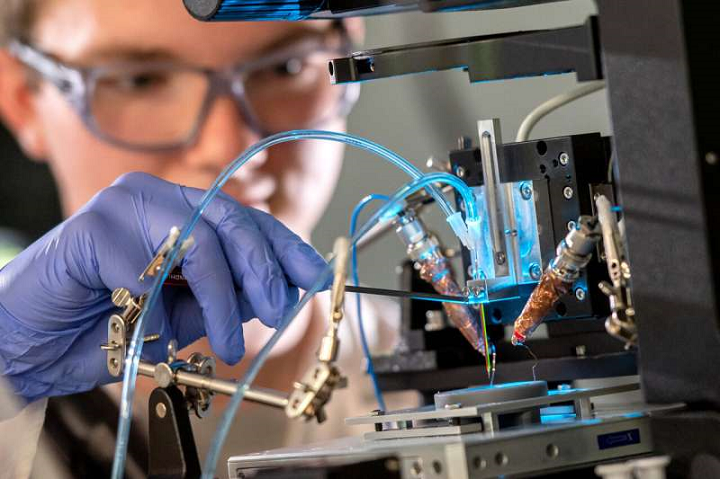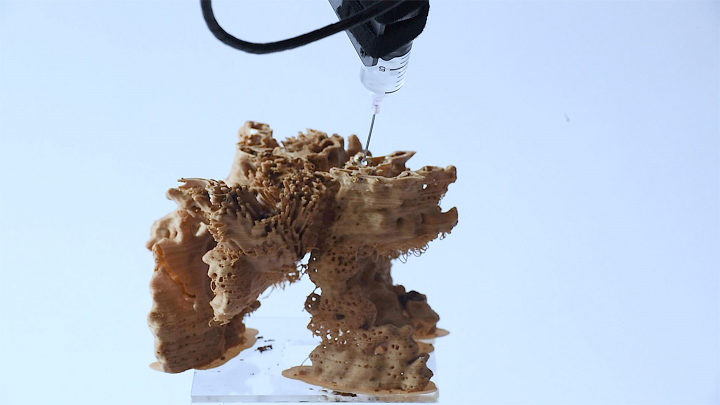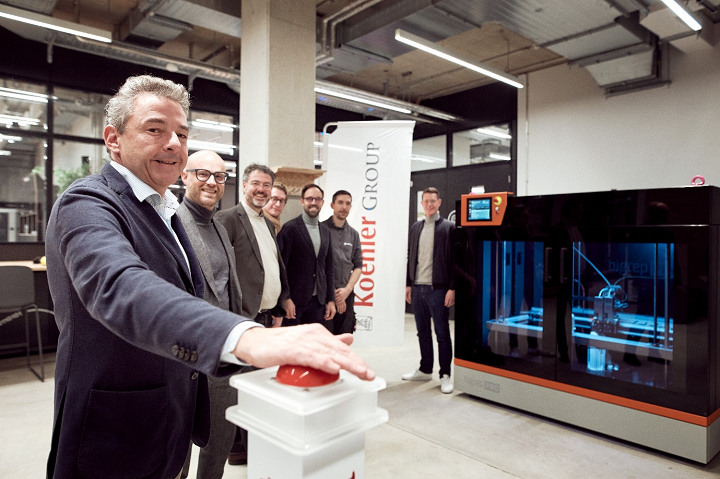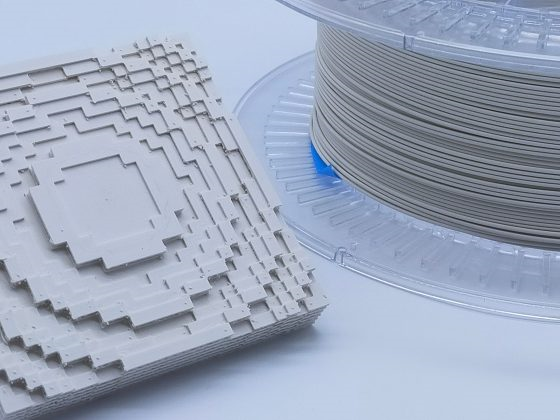We’re covering some interesting research in today’s 3D Printing News Briefs, as researchers from the University of Oldenburg are using tiny nozzles to 3D print nanoscale metallic structures. Moving on, BioLab Studio developed a 3D printed bio-scaffold for growing mycelium, and Zetamix 3D printed a new dielectric RF reflector. Finally, the Koehler Group is lending a BigRep PRO 3D printer to UnternehmerTUM’s MakerSpace.
University of Oldenburg Explores Nanoscale Metal 3D Printing
 A very special kind of 3D printer: Masters student Simon Sprengel makes some final adjustments to allow two metal solutions to flow simultaneously through the tiny printing nozzle. Image courtesy of University of Oldenburg.
A very special kind of 3D printer: Masters student Simon Sprengel makes some final adjustments to allow two metal solutions to flow simultaneously through the tiny printing nozzle. Image courtesy of University of Oldenburg.Using nanoscale 3D printing to create metal objects can open up many applications in areas like sensor and battery technology, microelectronics, and even nanorobotics, but it’s tricky. That’s why researchers at the University of Oldenburg in Germany are focusing on the technology, creating very small nozzles out of silica glass tubes to print extremely tiny metallic structures. As Dr. Dmitry Momotenko, who leads the university’s junior research Electrochemical Nanotechnology Group, explains, the team is trying to “assemble objects atom by atom” and “take 3D printing to its technological limits.” He specializes in electroplating, in which positively charged metal ions suspended in a salt solution are brought into contact with a negatively charged electrode; the two combine to form neutral metal atoms, which are deposited in a solid layer on the electrode. This method is what the team is trying to transfer to the nanoscale level.
The team built and programmed three special 3D printers for their work, with all components like the nozzle, material tubes, and control mechanism just a little smaller than usual. Even the smallest vibrations can mess up the process, so two of the printers sit atop 150 kg granite plates and are inside boxes that have been covered with an acoustic foam layer. Because the electromagnetic fields that would result from alternating current from a socket could interfere with the tiny voltages and currents needed to control nanoprinting, the lamps in the lab are battery-powered. The overall goal is to create a foundation for making batteries that can be charged 1,000 times faster than current models by shortening the pathways of the ions inside the battery. In order to achieve this, flat electrodes will need a 3D surface structure; hence, nanoscale 3D printing. Every member of the team is focusing on something specific, from optimizing the precision of the print nozzle and printing combinations of two different metals to learn how electric materials used in current lithium batteries can be structured using 3D printing. Needless to say, this is a project we should all be watching.
BioLab Studio’s 3D Printed Bioscaffold for Growing Mycelium
 BioLab Studio has created a system that uses a robot arm to maintain mycelium grafted onto 3D printed wood objects.
BioLab Studio has created a system that uses a robot arm to maintain mycelium grafted onto 3D printed wood objects.BioLab Studio, founded in 2017 by multidisciplinary architect and artist Dr. Natalie Alima, builds wooden bio-scaffolds to facilitate the growth of mycelium, maintained by a robotic arm, using 3D printed wood fiber sculptures. She uses a mixture fortified with coffee grounds and hemp fibers to build the scaffolding for mycelium spores, and the wood composite also serves as a nutrient source. A 3D program completes calculations to set up an optimized pattern of recesses on the scaffolds to either help or hinder the growth of the spores, dependent on structural needs. A wooden graft, implanted with the spores, is enclosed within two panels, and the mycelium then grows, acting as an insulation material that can also be eaten. The robotic arm features a moisture sensor that interfaces with the 3D printed object to implant, moisturize, and cultivate the mycelium. It all began by creating small sculptures that can be used as household objects, and now, Dr. Alima and two partners are working to scale up the technology so it can create more sustainable insulation systems for larger projects.
Dr. Alima said, “So not only is the machine tending to the organism, but also the organism is influencing the machine’s movement.
“[It’s] almost like a language between the two mediums, between the physical and the virtual realms.”
“I really tried to as an artist to embrace nature and show it off and kind of show that point that we’re working with nature.”
Zetamix’s 3D Printed RF Dielectric Reflector
In 2018, industrial company Nanoe launched Zetamix, a brand of ceramic and metal filaments compatible with FFF printers. Now, in a collaboration with The Laboratory of Electronics, Antennas and Telecommunications (LEAT), Zetamix has 3D printed a futuristic RF dielectric reflector with unique properties, thanks to its new Epsilon filament. Typical RF reflectors are often heavy, voluminous, hard to handle, and time-consuming to develop, not to much expensive. So a simpler, less costly option was needed, but it still needed to be able to reflect wave at certain frequencies and be transparent at others, in order to “enable multi-functional parameters.” This new dielectric reflector was printed out of Epsilon 2.2 and Epsilon 7.5 filaments on a Raise3D system, which made it possible to fabricate metasurface structures; this enabled flat parts with lightweight, complex discreet shapes, at a lower cost.
“This new innovative RF Reflector has an adjustable design and composition, making it interactable with a different range of frequencies. Since the Epsilon Filament comes in different permittivity, this characteristic allows the interference with different Frequencies (the 7.5 permittivity filament reaches out to 100 GHz) The ratio of the filament used can also take part in this unique mission, the adjustment of it can allow the interaction with complicated frequency rates usually almost impossible to reach,” the Zetamix website states.
Koehler Group Lends BigRep 3D Printer to MakerSpace
 Kai Furler, CEO of the Koehler Group, symbolically presses the start button for the development of future‐oriented prototypes on the BigRep PRO 3D printer in the MakerSpace.
Kai Furler, CEO of the Koehler Group, symbolically presses the start button for the development of future‐oriented prototypes on the BigRep PRO 3D printer in the MakerSpace.The core business activity of the Koehler Group is developing and producing high‐quality specialty paper. But it’s also dedicated to developing new business areas outside of special paper and energy production, and founded Koehler Invest to oversee its startup activities and help drive future technologies. It recently announced a strategic partnership with Europe’s leading center for business creation and innovation, UnternehmerTUM. As part of the collaboration, Koehler Invest purchased a large-format BigRep PRO 3D printer and is lending it to the center’s high-tech MakerSpace for one year, free of charge. The MakerSpace gives students, professionals, startups, and independent entrepreneurs a professional infrastructure to turn their ideas into prototypes, with access to innovative production technologies, like the industrial BigRep PRO, which offers several automated functions for fast, easy, and high-quality 3D printed plastic parts. The printer is located at the Munich Urban Colab location.
“The facilities save teams time and money in development, which reduces the risks for new start‐ups. Koehler successfully supports our innovations ecosystem and, with the BigRep PRO, we are particularly pleased with the latest addition to large‐format 3D printing in our machine pool,” said Florian Küster, Managing Director at MakerSpace GmbH from UnternehmerTUM.
Subscribe to Our Email Newsletter
Stay up-to-date on all the latest news from the 3D printing industry and receive information and offers from third party vendors.
You May Also Like
Profiling a Construction 3D Printing Pioneer: US Army Corps of Engineers’ Megan Kreiger
The world of construction 3D printing is still so new that the true experts can probably be counted on two hands. Among them is Megan Kreiger, Portfolio Manager of Additive...
US Army Corps of Engineers Taps Lincoln Electric & Eaton for Largest 3D Printed US Civil Works Part
The Soo Locks sit on the US-Canadian border, enabling maritime travel between Lake Superior and Lake Huron, from which ships can reach the rest of the Great Lakes. Crafts carrying...
Construction 3D Printing CEO Reflects on Being Female in Construction
Natalie Wadley, CEO of ChangeMaker3D, could hear the words of her daughter sitting next to her resounding in her head. “Mum, MUM, you’ve won!” Wadley had just won the prestigious...
1Print to Commercialize 3D Printed Coastal Resilience Solutions
1Print, a company that specializes in deploying additive construction (AC) for infrastructure projects, has entered an agreement with the University of Miami (UM) to accelerate commercialization of the SEAHIVE shoreline...






























